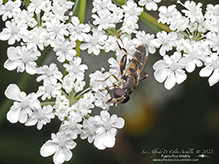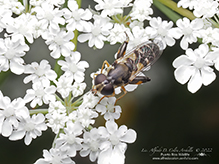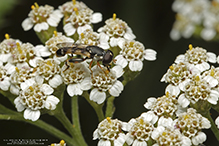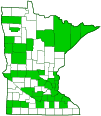common compost fly
(Syritta pipiens)
Conservation • Description • Habitat • Ecology • Distribution • Taxonomy
Conservation Status |
|
|||||||
| IUCN Red List | not listed |
|||||||
| NatureServe | NNR - Unranked SNR - Unranked |
|||||||
| Minnesota | not listed |
|||||||
Description |
||
Common compost fly is a small hoverfly. It is native to Europe but it has spread across the Northern Hemisphere. It was introduced into North America in the 1800s. It now occurs throughout the United States and southern Canada, and in northern Mexico. It is very common, one of the most common hoverflies in the world. It is common in Minnesota. Adults feed on the flowers of a wide variety of plants. They are found from mid-April to mid-November wherever these flowers occur. Larvae are found in wetlands near lakes, ponds, and rivers; and in compost, manure, and silage. They feed on decaying organic matter. Adults are slender and long, ¼″ to ⅜″ (6.5 to 9.5 mm) in length. They are wasp mimics. The head is hemispherical and slightly broader than the thorax. There are two large compound eyes on the sides of the head and three small simple eyes (ocelli) in a triangle on top of the head. The compound eyes are dark brown and bare, not covered with hair. On the male they meet at the top of the head. On the female they do not. The face is short and concave. It is not ridged (keeled). The antennae are short and have just three segments. The third segment is round. At the base of the third segment there is a long, forward-pointing bristle (arista) on the upper side. The arista is bare, not feather-like (plumose). The protruding mouthpart (proboscis) is short and fleshy. The thorax is black, is relatively long, and has three segments. There is a light brown spot at each front corner of the first thoracic segment. Each segment has four principal exoskeletal plates, one above, one below, and one on each side. The upper (dorsal) plates, from front to rear, are the prescutum, scutum, and scutellum. There are two gray, wedge-shaped marks on the front margin of the prescutum, just behind the head. There are no gray marks at the rear corners of the prescutum. The scutum and scutellum are unmarked. The scutellum has a thin outer edge and no fringe. The abdomen is slender and long, narrower and about two times as long as the thorax. It is black with yellow spots and has five segments. The second and third segments have two rounded spots that do not meet in the middle. The fourth segment has a narrow, broken, white band at the front margin, and a narrow, unbroken, yellow band on the rear margin. The wings are clear. There is a false vein (spurious vein) between the radius (R) and media (M) veins. The anal cell is long and is closed near the wing margin. The marginal cell is open. The R5, and M2 cells are closed. The front and middle legs are mostly yellow. The third segment (femur) of the hind leg is greatly enlarged. This is the feature that gives the insect its common name. It is black with two pairs of rounded orange spots. It has a row of short spines below on the inner two-thirds, and a row of longer spines on the outer third. There is no peg near the base. The fourth segment (tibia) is mostly black with yellow at the base and a yellow ring in the middle. |
||
Size |
||
Total length: ¼″ to ⅜″ (6.5 to 9.5 mm) |
||
Similar Species |
||
Habitat |
||
Wetlands, compost, manure, and silage |
||
Ecology |
||
Season |
||
Mid-April to mid-November |
||
Behavior |
||
|
||
Life Cycle |
||
|
||
Larva Food |
||
Decaying organic matter |
||
Adult Food |
||
Flowers of a wide variety of plants |
||
Distribution |
||||
|
Sources Telford, Horace S.. (1939). The Syrphidae of Minnesota. University of Minnesota. Minnesota Agricultural Experiment Station. |
|||
| 1/13/2023 | ||||
Occurrence |
||||
Common in Minnesota |
||||
Taxonomy |
|||
Order |
Diptera (Flies) | ||
Suborder |
Brachycera | ||
Infraorder |
Cyclorrhapha | ||
| Zoosection | Aschiza | ||
Family |
Syrphidae (Hover Flies) | ||
Subfamily |
Eristalinae (Drone Flies and Allies) | ||
Tribe |
Milesiini | ||
| Subtribe | Tropidiina | ||
Genus |
Syritta | ||
Synonyms |
|||
Musca pipiens Xylota proxima |
|||
Common Names |
|||
common compost fly thick-legged hoverfly |
|||
Glossary
Arista
A large bristle on the upper side of the third segment of the antenna of a fly. Plural: aristae.
Femur
On insects and arachnids, the third, largest, most robust segment of the leg, coming immediately before the tibia. On humans, the thigh bone.
Ocellus
Simple eye; an eye with a single lens. Plural: ocelli.
Proboscis
The tube-like protruding mouthpart(s) of a sucking insect.
Scutellum
The exoskeletal plate covering the rearward (posterior) part of the middle segment of the thorax in some insects. In Coleoptera, Hemiptera, and Homoptera, the dorsal, often triangular plate behind the pronotum and between the bases of the front wings. In Diptera, the exoskeletal plate between the abdomen and the thorax.
Scutum
The forward (anterior) portion of the middle segment of the thorax (mesonotum) in insects and some arachnids.
Spurious vein
A longitudinal, thickened line between the radius and media veins. It resembles a true vein but is not connected to any other veins.
Tibia
The fourth segment of an insect leg, after the femur and before the tarsus (foot). The fifth segment of a spider leg or palp. Plural: tibiae.
Visitor Photos |
|||||
Share your photo of this insect. |
|||||
| This button not working for you? Simply email us at info@MinnesotaSeasons.com. Attach one or more photos and, if you like, a caption. |
|||||
Alfredo Colon |
|||||
 |
 |
||||
 |
|||||
MinnesotaSeasons.com Photos |
|||||
|
|||||

Slideshows |
||

Visitor Videos |
|||
Share your video of this insect. |
|||
| This button not working for you? Simply email us at info@MinnesotaSeasons.com. Attach a video, a YouTube link, or a cloud storage link. |
|||
Other Videos |
|||
| Hover Fly Syritta Pipiens Fred Drake |
|||
About
Aug 14, 2020 Another Type Of Hover Fly in our Wildlife Meadow. |
|||
| Syritta pipiens (Linnaeus, 1758) ♂ - Cleaning time! Marcello Consolo |
|||
About
Aug 16, 2015 Syritta pipiens cleaning time |
|||

Created: 1/14/2021
Last Updated:



